As summer unravels in our garden world, the weather, as always shapes our gardens and our greenhouses
Keeping new plants alive in hot weather can be a challenge. Don’t let the dry spell cost you in terms of water or lost plants. There are so many ways to make the water you use in the garden work harder. It’s important that we save water and that the water that we apply is used efficiently.
Right now, our gardens are really starting to dry out. Despite the deluge of rain earlier in the year, the recent few weeks of cold nights, no rain and summer sun has already started to take its toll. With the danger of frost now passed, many of our greenhouse raised plants need planting out, but with that comes the challenge of getting them established into dry soil.
Reduce cultivation
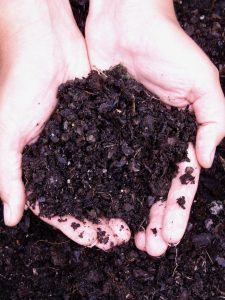
c. Martin Mulchinock
Moisture evaporates at the soil surface, so every time you dig, hoe, weed and plant you expose new soil to the surface, drying out the soil that is uncovered. Keep your cultivation to a minimum from April into summer. When hoeing just hoe the very surface of the soil and allow the weedlings to desiccate in the sun. When planting, keep the planting hole to a minimum and incorporate wet, rich, organic matter into the soil at the bottom to surround the roots. You can shade the soil surface around your plant roots using flat stones, to reduce the effect of the sun, but make sure you water thoroughly first.
Remove competition
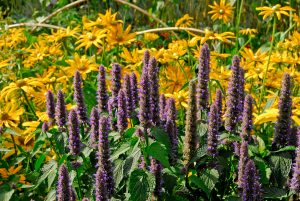
c. Martin Mulchinock
While I prefer to consider wildlings, weedlings and seedlings that self-seed in the garden as wildflowers, there is one instance when even I will remove them, and that is when they are growing in close proximity to newly planted plants. And that’s because all plants need water to grow and when you are trying to establish new plants in an area, competition for moisture can be detrimental to your plants. So, pull out anything growing within 30cm (12inch) diameter of your plants. You need to give your new plants the very best possible chance.
Water well
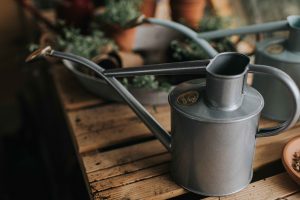
Wherever possible use rainwater to water your plants. That means you need to catch it and store it. It’s not difficult. Thousands of gallons or rainwater falls onto the roof of our home, garden sheds and greenhouses and this water can be directed into barrels, waterbutts and storage containers to use around the garden.
It’s best to water in the evening where possible so that the water you apply has a chance to soak in and reach your plant roots. If you’ve got newly planted trees and shrubs don’t wait until they are showing signs of stress. You need to get water down to their roots to ensure that the plants can support the top growth. It is far better to really soak the ground around anything newly planted once a week, than to water daily. That’s because superficially watering, only soaks the soil surface encouraging roots to grow near the surface, when in fact you really need to support the roots deeper down.
Check the soil
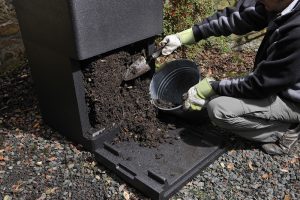
c. Hotbin
It’s a sobering reality seeing just how deep water soaks into the summer garden soil. Scrape away the surface soil in a test spot to see whether the water you have applied is really reaching down into the ground. It will give you an indication of whether you need to water more, or whether you’ve got it about right.
It is also a reminder that it is really important to Improve the soil especially before you plant, but summer is not the best time to do this. Instead plan to dig in rich, bulky, well-rotted organic matter, like homemade garden compost or leaf mould in the autumn and winter. Garden mulches will also help but do NOT apply these in the summer because they will create a barrier preventing any rainfall from reaching the soil beneath, they MUST be applied when the ground is wet and the soil is pretty much saturated.
Drip by drip

One of the most efficient ways to water your plants is drip by drip watering. You can set up a micro-drip system for your garden pots, your greenhouse planters or newly planted trees and shrubs. By connecting a system to a tap and a timer, it can ensure your plants are watered correctly and even when you are away. Another great tool for watering a new hedge or freshly planted trees, is a leaky hose, no not a hose with a hole in it, but a specially designed porous hose that gently seeps water to where it is needed the most. As it gently rewets the soil, the water is able to soak in slowly reaching down towards the root zone where it is needed the most.
Recycle your water

c. Jean Vernon
There are so many important reasons to recycle water. It’s a precious resource that we almost take for-granted. Saving rain water is a great place to start, but you can save so much more with a little extra effort. I have a watering can outside the kitchen door. When I wash veg the water left over goes into the can. It’s also used for cool, non-greasy washing-up water, I use an eco-washing up liquid which is better for the soil. It is surprising how quickly the can fills up and it’s very handy for watering the pots outside in the garden. You can re-use bath water, if you can siphon it outside, but this should be used on ornamental plants and not edibles.
Wildlife
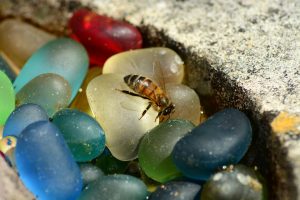
c. Martin Mulchinock
Don’t forget to leave bowls of water out for the wildlife in hot weather. Make an insect drinker from a shallow bowl filled with pebbles, marbles or sea-beans and fill with rainwater. The insects can drink safely from the islands. Keep your nectar rich plants well-watered to enable the plants to keep making nectar for your pollinating friends.


